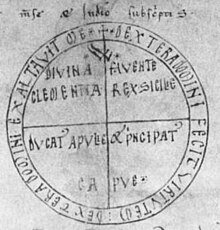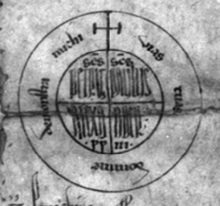Rota (diplomacy)
The rota (formerly also called orbiculus or circulus in research ) is an integral part of the eschat protocol of medieval papal documents. Together with the Benevalete and the comma , the Rota was in the spring of 1049 by Leo IX. (1049-1053) introduced, which was accompanied by a complete redesign of papal privileges. While the comma was only used in papal documents for a few decades, Rota and Benevalete were part of the design of privileges for several centuries .
The rota consists of two concentric circles with an equal-armed cross in the middle. The motto of the respective Pope is inscribed in the outer circle, the name and title of the Pope ( pp or p for papa ) are entered in the four inner quadrants .
From a documentary point of view, the Rota is a means of legal execution and at the same time for religious affirmation of the personal program of the respective Pope .
role models
Various possible models for the papal rota are cited in research. It seems particularly obvious that the Rota is based on the cross, which in papal documents before Leo IX. preceded the benevalete . Furthermore, it was pointed out several times that the design of the rota bears a clear resemblance to the coin image of the denarii of the 10th and 11th centuries, but also of earlier centuries. In the 19th century, Engelbert Mühlbacher cited the possibility that rota, benevalete and comma were meant to imitate the graphic symbols in imperial documents and thus find their correspondence in seals, rulers' monograms and recognition marks. A cross enclosed in a circle was also used from the 10th to the 12th centuries as an undersigned sign in papal, bishop and private documents both south and north of the Alps.
Development of the Rota
Leo IX is considered the creator of the papal rota, as well as the other two graphic symbols in the papal solemn privileges, which were increasingly used from the middle of the 11th century. For Leo IX. 38 original Rotae have survived today, of which he made at least 33 himself. The inscription consists on the one hand of the papal name and title in the four quadrants ( L | E || O | P ), on the other hand from Leo's motto ( M [isericordi] a | D [OMI] NI | plena e [st ] | t [er] ra ) together. The Rota was redesigned again and again under the popes of the 11th century and only received a fixed form under Paschal II (1099–1118). The names of the two princes of the apostles Peter and Paul ( SCS Petrus | SCS Paulus ) are now in quadrants one and two . The lower two quadrants contain the name of Paschalis II and his title as Pope ( Pasch PP | lis II ).
Just like the outward form, the personal part that the popes had in the exhibition of the Rota also changed. Did Leo IX. Almost all the Rotae were filled out themselves, so his successors only entered their names in the four quadrants, while the papal mottos were inserted by curia writers. With the introduction of the papal signature around 1100, the meaning of the Rota as an undersigned sign of the Pope actually ended , making personal participation obsolete.
In the course of the 14th century, the form of the formal privilege increasingly went out of fashion, which meant that Rota and Benevalete were no longer used.
The Rota in other forms of documents

The Rota has also been found in the documents of the Norman kings of southern Italy since 1129 . The Rotae in non-papal, southern Italian privileges , however, seem to be imitations of the Pope Rota.
Since 1038 (Fernando I), a rota has also been depicted on the privileges of the kings of Castile and later the kings of Spain, the so-called privilegios rodados .
literature
- Engelbert Mühlbacher: imperial and papal charter . In: MIÖG Vol. 4, Vienna 1893.
- Horst Enzensberger : Contributions to the chancellery and documentary system of the Norman rulers of Lower Italy and Sicily . In: Munich Historical Studies. Dept. of auxiliary historical sciences, Vol. 9, Kallmünz Opf. 1971.
- Joachim Dahlhaus, Appearance and Significance of the Rota in the Papers of Pope Leo IX. , in: Archivum Historiae Pontificiae 27, 1989, pp. 7–84 with 22 illustrations on 8 plates
- Joachim Dahlhaus: Appearance and meaning of the Rota in the papal charter . In: Peter Rück (Hrsg.): Graphic symbols in medieval documents (= historical auxiliary sciences vol. 3), Marburg 1996, pp. 407-423.
- Joachim Dahlhaus: Rota or signature. For the signing of papal documents by their issuers in the second half of the 11th century . In: Irmgard Fees, Andreas Hedwig et al. (Hrsg.): Papal documents of the early and high Middle Ages. External features. Preservation. Restoration. Leipzig 2011, pp. 249-303.
- Julius von Pflugk-Harttung (Ed.): Acta Pontificum Romanorum inedita. Documents of the Popes from 748 to 1198 , Tübingen 1881–1886.
- Julius von Plugk-Harttung: The bulls of the popes up to the end of the 12th century. Gotha 1901.
- Peter Rück : The high medieval papal document as a medium of contemporary aesthetics . In. Work from the Marburg auxiliary science institute (= elementa diplomatica 8), Marburg 2000, pp. 3–29.
- Thomas Frenz : Papal documents of the Middle Ages and modern times . Stuttgart 2010, ISBN 978-3-515-07788-0 .
Web links
- Examples of papal rotae ( Memento of May 6, 2011 in the Internet Archive ) on the pages of the Vatican Secret Archives
- Sample of Rota, Benevalete and Pope's signature in a 14th century chancellery manual
- Article on Privilegio Rodado in the Spanish Wikipedia
- Archivo Histórico Provincial de Toledo: Un privilgio rodado, el documento más antiguo del archivo, 9 May, 2018
Remarks
- ^ Joachim Dahlhaus: Appearance and significance of the Rota in the papal charter . In: Peter Rück (Ed.): Graphic symbols in medieval documents. Marburg 1996 (= Historical Auxiliary Sciences Vol. 3), p. 407.
- ^ Thomas Frenz: Graphic symbols in papal documents (with the exception of the Rota) . In: Peter Rück (Ed.): Graphical symbols in medieval documents, Marburg 1996 (= historical auxiliary sciences vol. 3) pp. 404–405.
- ^ Thomas Frenz: Papal documents of the Middle Ages and modern times. Stuttgart 2010, ISBN 978-3-515-07788-0 .
- ^ Dahlhaus: The emergence and importance of the Rota , p. 407.
- ^ Dahlhaus: The emergence and importance of the Rota , p. 411.
- ↑ Dahlhaus: Arrivals and Development of the Rota , pp. 408–409.
- ↑ Engelbert Mühlbacher: Imperial Charter and Papal Charter. In: MIÖG Vol. IV (1893), p. 504.
- ^ Dahlhaus: The emergence and importance of the Rota , p. 411.
- ^ Joachim Dahlhaus: Rota or signature. For the signing of papal documents by their issuers in the second half of the 11th century. In: Irmgard Fees, Andreas Hedwig et al. (Hrsg.): Papal documents of the early and high Middle Ages. External features. Preservation. Restoration. Leipzig 2011, pp. 249-250.
- ^ Dahlhaus: Rota or Signature , p. 251.
- ↑ Dahlhaus: Rota or Signature , p. 250.
- ^ Dahlhaus: Rota or Signature , p. 251.
- ↑ Dahlhaus: Rota or signature , pp. 287–289.
- ^ Dahlhaus: Rota or signature , pp. 288–290.
- ^ Frenz: Papal documents.
- ^ Horst Enzensberger: Contributions to the chancellery and document system of the Norman rulers of Lower Italy and Sicily . In: Munich Historical Studies. Dept. Historical Auxiliary Sciences Vol. 9, Kallmünz Opf. 1971, pp. 77–80.
- ^ López Garrido, JL: El privilegio rodado de los Reyes Católicos . Cadiz 1992.
- ^ Maria Luisa Pardo Rodríguez: La rueda hispana. Validación y Simbología , in: Papal Deeds and European Deeds. Studies on their formal and legal coherence from the 11th to the 15th centuries, ed. v. Peter Herde u. Hermann Jakobs, Cologne 1999 (AD supplement 7), pp. 241-258.
- ^ Mercedes Borrero Fernández: Seville, ciudad de Privilegios. Escritura y poder a través del privilegio rodado. Seville 1995.

